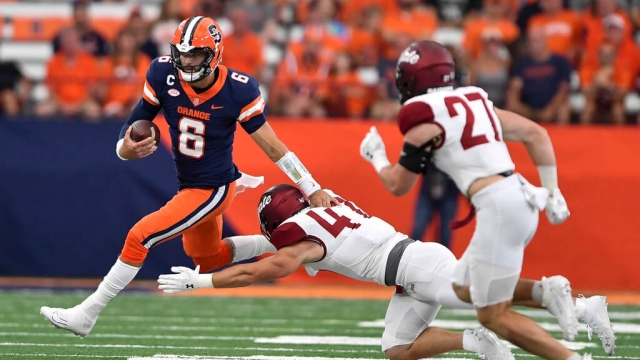There's no denying that fans love college football and basketball.
More than half of Americans polled said that they were avid or casual fans of college football in 2023, according to Morning Consult. And Nielsen reports the March Madness basketball tournament drew ten million viewers per game this year.
But only in America are must-watch TV sports played at institutions of higher learning.
So as college sports get increasingly commercialized, are they serving the best interests of players, their universities, and even their fans?
Here are two big issues at stake:
How large TV contracts impact traditional conferences?
The NCAA earns more than a billion dollars per year, mostly from television megadeals and marketing rights fees. The individual conferences earn even more. In 2020, for example, Disney signed a $3 billion contract with the SEC to broadcast games over ten years. And last year, the Big Ten signed a deal with Fox, NBC, and CBS worth more than seven billion dollars.
"A really large share of that revenue goes to pay coaches and athletic directors. So we have coaches today in the United States that are making eleven, twelve million dollars a year," says Andrew Zimbalist, an economist with Smith College.
But as schools pursue bigger and bigger TV deals, they are reshaping the very structure of college sports.
Take the Pacific-12 conference. In August, the PAC-12 lost eight of its twelve schools. Four will join the Big Ten, and four will join the Big 12. The other conferences had more lucrative TV deals.
Across all college sports, Stanford is the winningest school in NCAA history and has sent the most athletes to the Olympics. But now its conference is on the brink of collapse.
Paige Sinicki, a softball player with Oregon, which moved to the Big Ten, wrote on Twitter that "It's unfortunate to hear that my senior year I'll be playing as far as New Jersey-Rutgers."
"If we allow the old conference, the regional conference system, to fall apart, a lot of the kinds of attachments that people have had to college sports are going to dissipate, and it's going to be less successful," says Zimbalist.
Should student athletes be paid?
"Does [the NCAA] go towards trying to rebuild what it's always supposed to be in the amateur model and provide a real education and provide real, real health care for the student athletes? Or does it say, 'Oh, let's give up? It's never really worked anyway. Let's pay these athletes,'" says Zimbalist.
The NCAA used to enforce a policy of pure amateurism. Its rules prohibited students from being compensated in any way. Many colleges even insist on one-year athletic scholarships that don't automatically renew.
32 states and Washington, D.C., have now passed laws to regulate NIL, and the U.S. Congress has proposed legislation. Athletes have inked nearly 2,000 deals, according to a report by SponsorUnited. Nearly half included branded Instagram posts to promote their sponsors. Livy Dunne, for example, is a gymnast at LSU who has turned her fifteen million followers across social platforms into brand deals with Motorola and Vuori.
"The current NIL chaos means student-athletes are left to fend for themselves," said Rep. Cathy McMorris Rodgers (WA-R) in a recent congressional hearing. "And those at the top of their game must figure out how to maneuver through a multitude of agents, collectives, and high-dollar contract offers all while maintaining their academic and athletic commitments."
Some say allowing student athletes to profit from their own brands is insufficient. The only fair solution is to pay college athletes, said ESPN's Jay Bilas.
"All the athletes are asking for is the same economic rights as literally everyone else gets in this multi-billion dollar business," he said.
Others say the answer should be less commercialism, not more. Some feel that paying salaries to college athletes would benefit revenue-generating sports but harm non-revenue-generating sports. Those sports are generally subsidized by the more popular ones at big schools.
"The creation of an employee-employer model would significantly threaten this current dynamic and alter everything we know about how sports outside football and men's basketball are supported," said Caley Mudge, a softball player with Florida State.
Zimbalist says college sports must not professionalize. "We need to reinforce the amateur model, the educational first model," he says. 98% of Division 1 football and men's basketball players never play a game in the NFL or NBA, he adds.
"What we need to give them is a robust education, and we need to take care of their bodies. There needs to be adequate medical provision for them, not just when they're playing but for years afterwards from the injuries that they suffered," says Zimbalist.
The debate continues across campuses while revenues rise. But the athletes and their fans know the "money genie" is never going back in the bottle.
SEE MORE: Equal pay in women's sports: The challenge for female athletes
Trending stories at Scrippsnews.com



